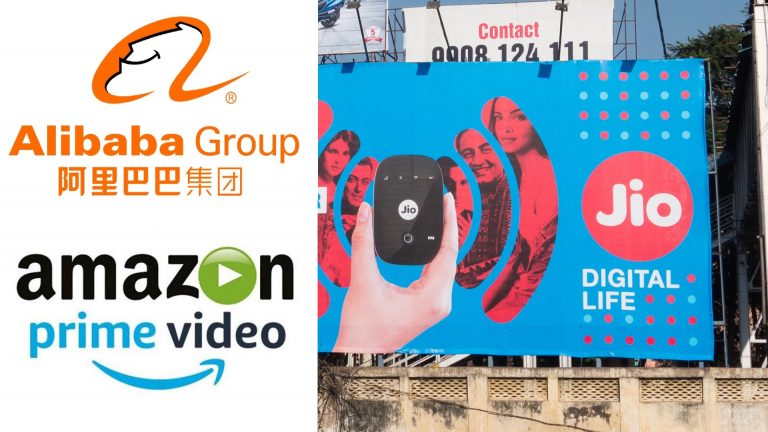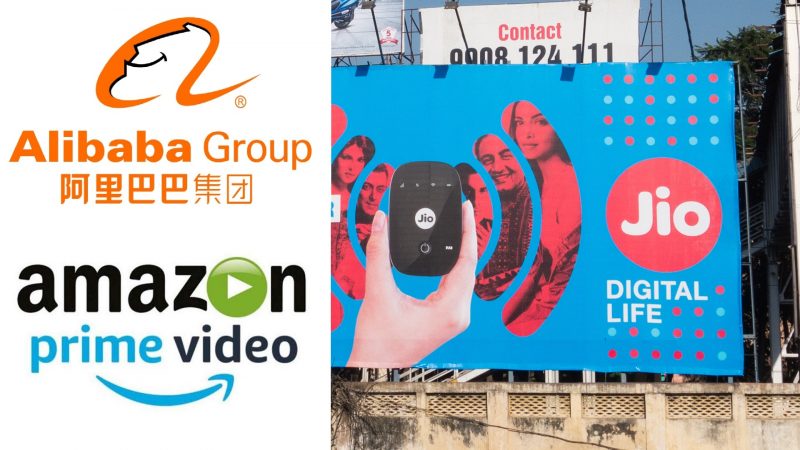
Reliance JIO the fastest growing telecom service provider in India provides data, voice, SMS, and applications. The disruption caused by JIO in the telecommunications industry is unprecedented and has enabled millions of consumers with value services.
It has gained 4G/LTE market share far ahead of its service provider competition and has caused rapid consolidation in the industry. Several telecom operators in India have either merged, closed business or filed for bankruptcy, while those who survive are facing straight quarterly losses.
The real story is though that JIO seems to be having its eyes set on a much larger industry and its business model seems to be replicating that of larger global conglomerates such as Alibaba and Amazon.
With its wings spread across digital commerce, payments, video, data center, healthcare, and social media these large conglomerates have unique insights into consumer behaviors and are now aiming at not just meeting and predicting demand but creating it.
Jio’s long-term strategy is to establish its presence across payments, both Pay TV and Video on demand, messaging, print, cloud data center, commerce, social networking, healthcare and other industries so that it can cross leverage data across various platforms and analyze consumer behavior to not just predict but create demand through use of AI / ML algorithms.
In line with the digital strategy of all global conglomerates- Alibaba, Google, Tencent, Amazon, Apple and some of the other multi-country telecom operators like Telefonica
Jio will and is already monetizing these services in two ways
- Hard and Soft bundling as part of both Mobile and eventually broadband plans
- Other Digital models such as advertising, subscription, start-up fee
In the near term, Jio will continue to expand
- Jio Music- the most downloaded app in Feb 2018. Revenue model subscription and advertisement
- Jio TV and Jio Cinema- acquisition of Network 18, deals with Alt Balaji, Eros Now and others. Revenue model subscription and advertisement
- Jio Money- revenue model through interest on available balance
- Jio Chat- revenue model advertising
- E-commerce using Jio Money to buy from Kirana stores
With the launch of IOT Jio will further launch services for
- Smart Homes
- Smart Grids
- Fintech- Insurance, Banking
- Digital Farming and Food
- Smart Building
- Smart Manufacturing
- Connected Cars
JIO will eventually enter in Video space in a much bigger way by offering Pay TV services apart from currently Over The Top only services. It could be either through Satellite or FTTX

Data is the new Oil
It’s very clear that new companies and business models are about who controls reams of data generated by humans and machines. Our daily lives are changing the way we interact with each other and with gadgets and machines around us.
It is expected that by 2021 there will be close to 5 billion smart devices out of which roughly 3 billion would be on device artificial intelligence enabled and 2 billion would be local cloud artificial intelligence enabled. With devices including smartphones impacting numerous interactions, they would generate volumes of structured and unstructured data. Siri, Google Assistant, Bixby, Alexa, and Duer are becoming first interfaces to people with heavy advanced machine learning programs running in the cloud and local neural processing unit in chipset enabling natural language processing and interactions.
Globally we generate roughly 2.5 quintillions (1 followed by 18 zeros) bytes of data each day today and will generate around 163 zeta bytes (1 followed by 21 zeros) of data a year by 2025. There are various ways you can use this data to glean language, vision, text, video, and numerical information that can be processed either on the device or on the cloud.
You can run self-learning programs to train themselves and the hardware or machine on which they are running. With multiple programs feeding each other and training themselves on this vast amount of data, and enabling self-learning they can emulate reality in the virtual world which can define how we behave.
There are roughly 6000 products made from petroleum starting from fertilizers to vitamin capsules and the idea is to use data in a way that can enable products, services and ways to do business.
Smart grids, connected cars, smart cities, smart buildings, smart manufacturing, connected health, Fintech, and digital farming and food are all examples of using data in a way to redefine how business is done.
Data is the new reality, and most of the digital conglomerates have realized its value. Whether it is massive data centers on land or under the sea, the objective is to enable abilities to possess a massive amount of data, process it and then use it to enable new business models.
Alibaba in China
Alibaba may have started as just an online market place enabling transaction but is now a $40 billion company with market cap of more than $500 billion. Alibaba achieved this feat in less than 20 years.
Alibaba today is known as a Chinese multinational e-commerce, retail, Internet, AI, and technology conglomerate founded in 1999 that provides consumer-to-consumer, business-to-consumer and business-to-business sales services via web portals, as well as electronic payment services, shopping search engines and cloud computing services.
Today Alibaba has interests in digital commerce through Taobao and Tmall, payments through Alipay, video streaming through Youku, Tudou, search through Shenma, and social media through Sina Weibo. Alibaba’s competitor in China Tencent has similar interests in JD direct sales platform, Wechat pay, Tencent videos, Sogou and Wechat.
In the digital world the intent is to collect data at every touch point across, commerce, payments, video streaming, and entertainment, search and social media and then use this data across platforms to know customers as well as they know themselves and then not just meet demand but create demand.
Alibaba and JD.com singles day sales crossed $45 billion in 2017. The one-day shopping event is bigger than Black Friday and Cyber Monday combined.
The ability to generate cash and improvise ways to business through cross leveraging data across platforms cannot be more glaring than this single day sales event, wherein you could buy goods from a social networking app through payment enabled by the same service provider while your data is getting collected and products are getting personalized and targeted to you by the same company.
Amazon globally
E-commerce sales as a percentage of the total will touch around 20% in the United States by 2023 and 25% in China. Amazon currently holds a market cap of $833 billion with revenues of $177 billion a multiple of 4.7. Walmart in contrast currently has a market cap of $240 billion and revenue of $500 billion a multiple of 0.48. Started in 1994 Amazon grew from selling only books to becoming the largest internet retailer in the world after Alibaba and becoming a cloud computing firm.
Riding on massive data that Amazon collected about its consumers Amazon now offers products and services for grocery delivery, on-demand video and music streaming, on-demand cloud computing, AI-enabled virtual assistant, application store, cloud storage platform, smart speakers, e-reader, digital media player, tablet computer, digital video game distribution, developing television series, distributing and producing films and comics, and wireless devices.
In just 20 years Amazon has disrupted industries and created new business models on what could be called as extracting products and services out of the new oil- data
Telecom operator spending on digital platforms and content
Telecom operators globally have joined the race in expanding beyond offering just data and voice. Telefonica globally has been an early adopter of digital a journey they started in 2012. Since then they have spent close to $48 billion Euros, in digitalizing the underlying platforms.
Aura is the name of machine learning or ‘cognitive intelligence’ function which will automate responding to common customer queries as one of its first applications.
AT&T completed its acquisition of Time Warner in June 2018 bringing together global media and entertainment leaders, Warner Bros., HBO and Turner with AT&T’s leadership in technology and its video, mobile and broadband customer relationships.
The joint entity will have a market cap of $197 billion with access to content and distribution. Netflix just a streaming service with 125 million subscribers has a market capitalization of $170 billion. Turk Telecom, NTT, Telstra, America Movil, SK Telecom, SK broadband, Singtel all now have 20% to 60% penetration of over the top or mobile subscription-based video service in their total video connection base. Pay-TV operators are now seeing an increasing play of internet in their traditional services.
From a technology standpoint, roughly 35% of tv connections are now delivered by IPTV indicating a move towards converged offering with a fixed line.
It is becoming increasingly clear that with new technologies such as AI, AR/VR, IOT, Cloud and analytics emerging, the incumbent telecom operators have realized that they can no longer sustain existing business and stay profitable unless they coalesce various business streams to know more about their customers.
Virtual Assistants and Artificial Intelligence
On the consumer front, artificial intelligence is making headway faster than people expect. Roughly 60% of smartphones now have voice assistants that are helping adopt artificial intelligence. Google assistant is the market leader with 50% market share of virtual assistants on a smartphone, followed by Apple Siri at 30% and Baidu at 20%. Alexa is gradually becoming a household name. So, with fundamental and new services and products getting launched, artificial intelligence will find its application starting from voice assistants, and image recognition to massive data churn on a cloud in the background finding patterns, spotting behaviors, personalizing and predicting purchase decisions. In a very subtle form of changing individual and mass behaviors.
Internet video advertising and subscription
The video will account for up to 80% of internet traffic by 2021. Its only natural that likes of Netflix, Amazon Prime, Youtube and Facebook will see both advertising and subscription-based model emerging. Global video internet ad revenue is expected to reach only $60 billion by 2021. This is expected to grow from the current 12% to 17% of Total TV advertising revenue of around $160 billion by 2022. Pay TV growth has slowed and stagnated while internet-based content consumption is on the rise for advertising dollars to move from pay tv to the internet. This trend augurs well with a more converged landscape of telecom, internet and Pay TV. So a new player cannot just achieve quad play- television, broadband, fixed and mobile phone- but also combine it with internet-based video and music services to go fully digital in the true sense. It’s an opportunity and disruption at an unimaginable scale.
India Video and Music ecosystem
Barely had India’s DTH providers- Airtel, Dish, Tata Sky, Videocon- had grown profitable that the video ecosystem started to change. Increasing video consumption over the internet meant new players in advertising and media agencies, delivery platforms, content aggregation, broadcasting and content, and platforms emerge. DTH and cable operators are now competing with Hotstar, Netflix, Voot, ditto TV etc. Reliance Jio has jumped into content aggregation and delivery platforms like Apalya, Kaltura, Digivive, and Saranyu are gaining grounds.
Similarly, on the music front Gaana, Saavn, Wynk, Hungama and apple music all have seen a steady increase in their paid subscription
AI team by Reliance JIO
In June 2018 Reliance Jio Infocomm started hiring AI team. It’s just a beginning to the long and enormously successful journey that has been traversed by Alibaba and Amazon in their home country and the rest of the world.